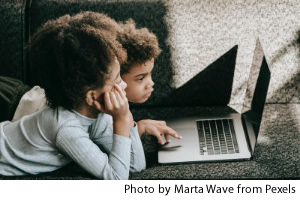We live in a world where learning and technology are intrinsically linked, especially in the minds of our youth. But do today’s students process information differently because it comes on a digital device? Is there a correlation between technology use and plummeting literacy rates? And is the way our young people consume information negatively impacting their growth as learners?
I recently discussed these questions with two education experts on my podcast, What I Want to Know. Earl Martin Phalen is the founder and CEO of Summer Advantage and the George and Veronica Phalen Leadership Academies, and Dr. Maryanne Wolf is the Director of the UCLA Center for Dyslexia, Diverse Learners, and Social Justice. Phalen is well-known for his work improving literacy in marginalized populations, and Dr. Wolf has done extensive research on brain development and literacy.
Technology can engage students and enhance their literacy skills
Phalen is a firm believer in the power of literacy. “Practicing reading and getting comfortable with language helps you become a better writer, helps you become a better critical thinker, and allows you to express yourself better when you’re speaking,” he explained. And he is enthusiastic about the role technology can play in engaging students.
“Technology can stimulate our scholar’s imaginations in different ways,” Phalen said. “A scholar at one of our campuses reenacted Rosa Parks. They wrote the play. They modernized it, as if Rosa Parks lived in 2020. They directed it. They did the sound on it. They did the green screen and learned about all those things. And that’s just one example of using technology to enhance writing skills, public speaking skills, and stimulating imagination while learning about a critical historical moment.”
But integrating technology into lesson plans can be a challenge. “Some of our teachers had never really used technology so we stumbled,” he shared. “But I loved the fact that folks stuck with it to help the children learn.”
This is one of the more clear-cut examples of how technology can have a positive impact on literacy. But it’s also important to know the potentially negative impacts so we can address them head on.
Digital devices inhibit the development of deep reading skills
Dr. Wolf explained that thirty years ago, 60 percent of children read weekly. Today only 12-15 percent of kids pick up a book each week.
Students are still acquiring knowledge from digital devices, but there are complexities in reading paperback or hardcover books that today’s children are missing.
“The reading brain is plastic, that will reflect the affordances or characteristics of the medium,” Dr. Wolf explained. Adults who grew up reading a printed book or a magazine weekly have what she calls a “deep reading brain,” which is better equipped and developed to use “deep reading processes” such as empathy and critical thinking.
Today, young people are reading on digital devices at an increasingly fast pace. This causes students to miss much of the information, the smaller details that contribute to a holistic, deep-reading brain.
“There’s a lot of data now that shows that kids are not comprehending what they’re reading in the same way because that attention is being so distracted,” Wolf said. “They’ve learned a mode of reading that’s more involved in just getting the main words and doing it fast, which literally neglects the most important parts of reading,” like comprehension and analysis.
Parents and teachers should take a measured approach to technology
With all of that in mind, what I truly wanted to know was what should we be doing differently? What can we do to get kids to focus on the most important parts of reading? What can teachers and parents do to help their students develop a deep reading brain?
“The first five years [of life] I want all children and all parents to be involved in reading, at the very minimum, make it a nightly ritual of affection and association with books,” Wolf said. “And no child can be allowed to go into fourth grade without being as fluent and automatic [with reading] as possible because fourth grade is when we lose our kids.”
Data from Annie E. Casey Foundation shows that students who were not proficient readers by the end of third grade were four times more likely to drop out of high school.
Reading kids physical books while they are young might sound like an obvious solution to this problem, but in reality, that isn’t happening enough. Parents and educators need to do a better job of finding a middle ground between technology and literacy that starts when kids are born.
Technology has become a pivotal tool in expanding the possibilities for how we learn. But that doesn’t mean we can simply abandon our roots. There is tremendous value in picking up a physical book and carving out that reading time to stimulate our students’ brains.
To discover more about how literacy education needs to evolve in a modern society, listen to Episode 7 of my What I Want to Know Podcast and join the conversation using #WIWTK.
Content provided by:

- Smarter Classrooms for Today and Tomorrow - May 1, 2024
- CoSN: The Basics - March 28, 2024
- #CoSN2024 Remote—How to Do It - March 28, 2024

